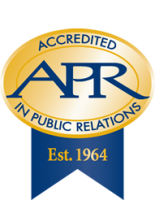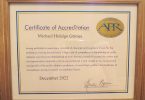I’ve never been one to put a ton of stock in letters behind one’s name. It’s probably something to do with my Pentecostal roots — a fundamentalist religion (as conveyed to me from birth three times a week and every day during the weeklong summer tent revival) that decried the sin of pride.
Ten years as a print journalist didn’t push me toward grad school, and even when I entered the public relations field, I continued to cling to my spot on the sidelines, focusing on tactics rather than a wider scope or the spotlight. I was, and am, happiest promoting someone or something — anything — other than myself.
But about a year ago, a PR professional whom I greatly respect, asked me two questions: 1.) Why do I always lead with my years of journalism in my elevator speech about me, when I’ve been in PR twice as long, and 2.) Why I didn’t have my APR?
No one had ever asked me either question. I didn’t have great answers.
My friend pushed me to see myself as what I am, not what I was, and to seek my APR because, “if you’re going to be in the profession, why wouldn’t you be as good at it as you can be?”
That push led me to a greater understanding of the profession, its history and the strategic role PR should be playing — that I should be playing.
Sure, I felt a little silly going back to the classroom to learn things that kids in school could spout without thought. But happily, it wasn’t really a classroom; it was a conference room, and my cohort group was a good mix of age and experience. My local PRSA Chapter put on a great course, and my mentor gave me great advice and support.
The Readiness Review was a great exercise for me. It wasn’t that I didn’t know how to practice my craft. I had all the elements down. But in all my positions — communications posts at state agencies; assistant press secretary/communications director for a governor, agency rep, director of external communications for a publicly traded company — I’d never had to prove it to anyone, let alone a panel of my peers.
My worth as a PR pro, in large part, has been tied directly to my success in media relations. I’ve offered strategic counsel and had success there, too, but I’ve been thanked or rewarded most often because of the media relations slice of my PR professional pie.
Going through the APR process made me realize that it is long past the time I shed my persona as a reliable yeoman tactician who gets the job done. It’s time to demand research before reaction, to proactively offer strategic counsel, to use all the tricks in my bag and make it clear that it’s a damn big bag.
It’s still up to me to showcase the expertise those three letters signify. The APR process is a great reminder of why I confidently (as opposed to pridefully) should.
Cheryl Reed, APR, has been a practicing PR professional since 1993, when she joined the Indiana Utility Regulatory Commission as its public information officer. She later served as deputy press secretary/director of communications for Governor Frank O’Bannon, was in private practice and has spent the last 10 years at Angie’s List, where she is currently director of external communications for the publicly traded company, and serves groups devoted to youth development and family support.








[…] “Old Dogs/New Tricks and the APR” is a delightful day-in-the-life story of a seasoned PR pro and her struggle to get accredited. Surprisingly, it scored an average readability score of 9. The post was conversational and flowed so well that I read it in under a couple of minutes. I think this post and most other posts on the site should consistently read around the 7th grade level. […]
Thanks, Audrey!